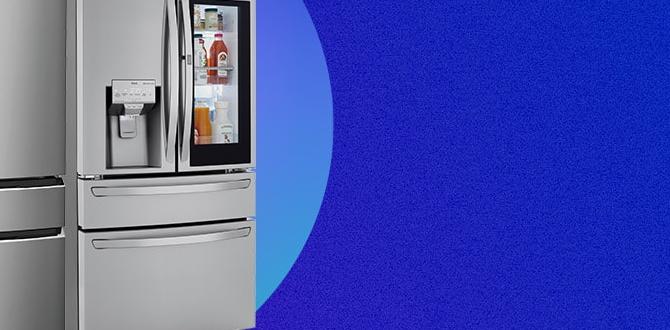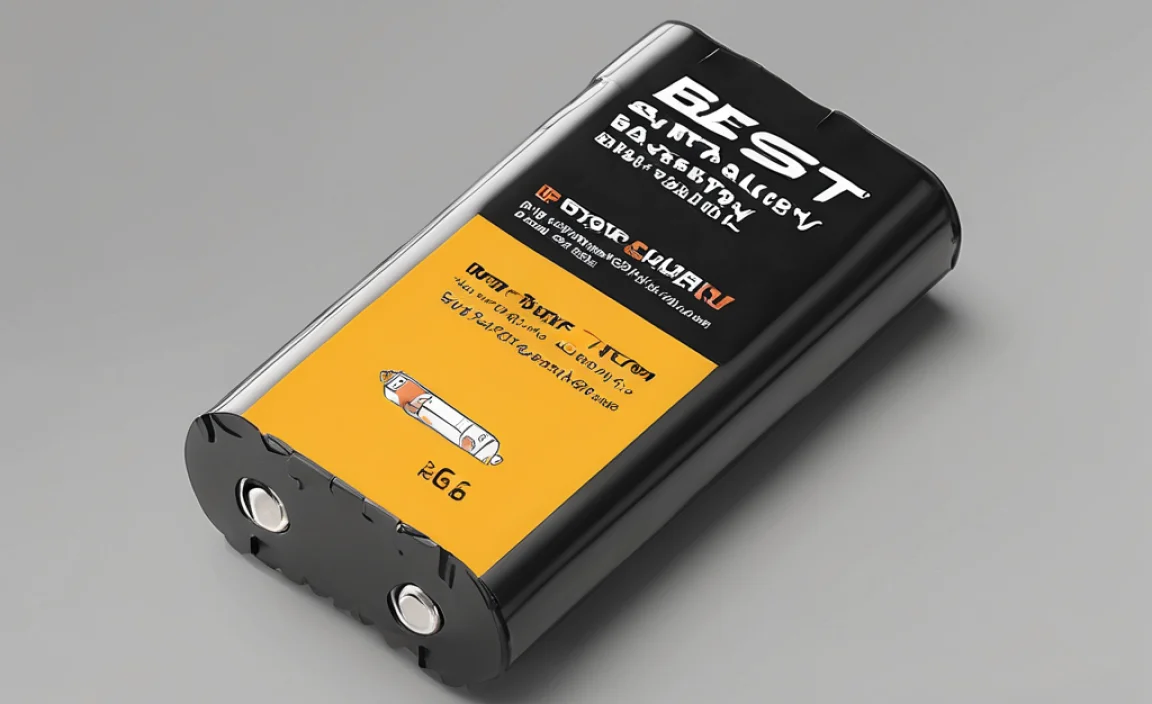Quick Summary: For your 2014 Ford Fusion, you’ll need a Group Size 48 (also known as H6 or 24F) battery. Ensure it has a Cold Cranking Amps (CCA) rating of at least 600 for reliable starting power, especially in colder weather. Always double-check your owner’s manual or a reliable auto parts store’s fitment guide before purchasing.
What Size Battery for 2014 Ford Fusion: Your Essential Guide
Is your 2014 Ford Fusion struggling to start? Or maybe you’re just planning ahead for battery replacement. Finding the right car battery can feel like a puzzle, with all sorts of numbers and sizes out there. But don’t worry, it’s simpler than you think! This guide will walk you through exactly what battery your 2014 Ford Fusion needs, making the process easy and stress-free.
We’ll cover everything from understanding battery group sizes to knowing what kind of power your car needs to run smoothly. We’ll also touch on why choosing the right battery is crucial for your car’s performance and longevity. Get ready to feel confident about your next battery purchase!
Understanding Car Battery Basics
Before we dive into the specifics for your 2014 Ford Fusion, let’s get a handle on what makes a car battery tick. Think of your car battery as the heart of your vehicle’s electrical system. It provides the initial jolt of power to start the engine and then keeps your car’s lights, radio, and other electronics running when the engine isn’t on or is at low speeds.
Car batteries have a tough job. They need to deliver a lot of power quickly to get your engine turning over, especially on cold mornings. They also need to be reliable, ready to work day in and day out. Over time, like any other component, batteries wear out and need to be replaced. Knowing the right type and size is key to ensuring your car starts reliably and all its electrical systems function correctly.
What is a Battery Group Size?
When you look for a car battery, you’ll see a “group size” number. This isn’t about how big or heavy the battery itself is, but rather about its physical dimensions (length, width, height) and the placement of its positive and negative terminals. Cars are designed to fit batteries of specific group sizes because the battery tray and hold-down clamp are made to accommodate them.
Using a battery with the correct group size ensures it fits securely in its tray and that the battery cables can connect properly. For the 2014 Ford Fusion, a common and recommended group size is the Group Size 48. You might also see this referred to as H6 or, less commonly for this specific model, 24F. Always confirm with a reliable fitment guide.
Cold Cranking Amps (CCA): Why It Matters
Beyond the physical size, you’ll see a rating called Cold Cranking Amps (CCA). This is a really important number. CCA measures the number of amps a battery can deliver at 0°F (-18°C) for 30 seconds while maintaining a specific voltage. In simpler terms, it’s a measure of the battery’s ability to start your engine in cold weather.
The colder it gets, the thicker your engine oil becomes, and the harder the starter motor has to work. A higher CCA rating means your battery has more power to overcome this resistance and get your engine firing, even on the chilliest mornings. For a 2014 Ford Fusion, aiming for a battery with at least 600 CCA is a good rule of thumb for reliable starting in most climates.
Finding the Right Battery for Your 2014 Ford Fusion
So, let’s get down to business. What exact specifications should you look for when buying a battery for your 2014 Ford Fusion? We’ll break it down into the essential details:
Recommended Group Size: Group 48 (H6)
As mentioned, the most common and recommended battery group size for the 2014 Ford Fusion is Group Size 48. This size is also often labeled as H6. You might occasionally see a 24F listed, but Group 48/H6 is generally the correct fit for most 2014 Ford Fusion models. This size ensures the battery will physically fit into the car’s battery tray and that the terminals will align with your car’s battery cables.
Cold Cranking Amps (CCA) Rating
For optimal performance, especially if you live in an area with cold winters, your 2014 Ford Fusion’s battery should have a minimum of 600 CCA. Some batteries might offer higher CCA ratings, which is perfectly fine and can offer even better cold-weather starting power. Unless you’re in a consistently warm climate, don’t go significantly below 600 CCA.
Reserve Capacity (RC)
While CCA is king for starting power, Reserve Capacity (RC) is also good to consider. RC measures how long a fully charged battery can deliver 25 amps at 80°F (27°C) before its voltage drops below a usable level. A higher RC means your battery can power essential accessories like headlights for a longer period if the alternator isn’t working, or if the engine is off.
For a 2014 Ford Fusion, an RC of around 100-120 minutes is generally sufficient. It indicates a robust battery that can handle the demands of modern vehicles.
Battery Type: Which is Best?
There are a few common battery types available, and understanding the differences can help you make an informed choice:
- Flooded Lead-Acid (Wet Cell) Batteries: These are the traditional type of car battery. They are generally the most affordable. They require periodic maintenance (checking electrolyte levels) unless they are “maintenance-free” models. They perform well in most conditions but can be sensitive to extreme temperatures and vibrations.
- Enhanced Flooded Batteries (EFB): A step up from standard flooded batteries, EFB batteries are designed for vehicles with basic start-stop technology or higher electrical demands. They offer better durability and charge acceptance.
- Absorbent Glass Mat (AGM) Batteries: AGM batteries are sealed and maintenance-free. They use a special mat to absorb the electrolyte, making them more resistant to vibration and leaks. They generally offer superior performance, longer lifespan, better deep cycling capabilities, and are excellent in extreme temperatures. Many modern vehicles, especially those with advanced electronics or start-stop systems, often come with AGM batteries.
For a 2014 Ford Fusion, a standard flooded lead-acid battery is often suitable. However, if your Fusion has features like start-stop technology or if you frequently drive in extreme conditions, an AGM battery can provide better performance and longevity. Always check your owner’s manual to see if your specific model came equipped with an AGM battery, as this often indicates a need for a replacement with the same technology.
How to Confirm the Correct Battery Size
While Group Size 48 (H6) and 600+ CCA are strong indicators, it’s always best to confirm. Here are the most reliable ways to ensure you’re getting the right battery:
1. Consult Your Owner’s Manual
Your Ford owner’s manual is the definitive source for your vehicle’s specifications. It will clearly state the recommended battery group size, and sometimes even specific performance requirements like CCA. Make it your first stop!
2. Use Online Battery Finder Tools
Most major battery manufacturers and auto parts retailers have excellent online tools. You simply enter your vehicle’s year, make, model, and engine size, and they will provide a list of compatible batteries. These tools are generally very accurate.
For example, you can use tools from:
These sites will help you confirm if Group Size 48 (H6) is indeed the correct fit for your 2014 Ford Fusion. They often use extensive databases to match parts to vehicles.
3. Visit a Professional Auto Parts Store
The experts at your local auto parts store are a great resource. They have access to detailed fitment guides and can look up your vehicle to tell you exactly which batteries will work. Many will even check your current battery to confirm its size and provide recommendations.
4. Inspect Your Current Battery
If your current battery is still in the car and accessible, you can often find the group size information printed directly on the battery’s label. Look for a sticker or molded plastic marking that says “Group Size 48” or “H6,” along with its CCA rating.
Key Specifications for 2014 Ford Fusion Battery
To make it super clear, here’s a summary of what to look for:
| Specification | Recommended Value for 2014 Ford Fusion | Notes |
|---|---|---|
| Group Size | 48 (H6) | Crucial for physical fit and terminal placement. 24F might sometimes be listed but 48/H6 is most common. |
| Cold Cranking Amps (CCA) | 600 or Higher | Essential for reliable engine starting, especially in cold weather. Higher is generally better. |
| Reserve Capacity (RC) | 100+ Minutes | Indicates battery’s ability to power electronics if alternator isn’t running. |
| Battery Type | Flooded Lead-Acid or AGM | AGM is recommended for vehicles with start-stop systems or high electrical loads. Check owner’s manual. |
| Voltage | 12 Volts | Standard for all modern passenger vehicles. |
When to Replace Your Car Battery
Car batteries don’t last forever. On average, they last anywhere from 3 to 5 years, but this can vary depending on climate, driving habits, and battery quality. Here are some signs that it might be time to replace your 2014 Ford Fusion’s battery:
- Slow Engine Crank: The engine sounds sluggish when you try to start it, taking longer than usual to turn over.
- Clicking Sound When Starting: You turn the key, and all you hear is a rapid clicking noise. This often means the battery doesn’t have enough power to engage the starter motor.
- Dim Headlights or Interior Lights: Lights may appear dimmer than usual, especially when the engine is off or at idle.
- Warning Lights: The battery warning light on your dashboard illuminates. This light is shaped like a battery and indicates a potential issue with the charging system or the battery itself.
- Old Age: If your battery is already 3-4 years old and you’re noticing any of these symptoms, it’s wise to get it tested. Proactive replacement can prevent being stranded.
- Swollen or Leaking Battery Case: This is a sign of serious internal issues, often caused by extreme heat or overcharging. Replace it immediately and safely.
To check the health of your battery, you can use a multimeter to test its voltage (a fully charged battery should read around 12.6 volts when the car is off) or take it to an auto parts store. Most offer free battery testing services. For more in-depth testing, you might need a specialized battery load tester, which is what professionals use.
The National Highway Traffic Safety Administration (NHTSA) recommends regular vehicle maintenance, including checking your battery, to ensure safety and reliability on the road.
Safety First: Replacing Your Car Battery
Replacing a car battery is a task many DIYers can handle, but it’s crucial to do it safely. Batteries contain sulfuric acid and can release flammable hydrogen gas. Always prioritize safety!
Tools You’ll Need:
- Safety Glasses: To protect your eyes from acid splashes or debris.
- Gloves: Heavy-duty gloves to protect your skin from acid and dirt.
- Wrench Set: Typically a 10mm, 13mm, or 15mm wrench for battery terminals and hold-down clamps.
- Battery Terminal Cleaner/Wire Brush: To clean corrosion from terminals and cable clamps.
- Anti-Corrosion Spray/Grease: To protect terminals after installation.
- New Battery: The correct Group Size 48 (H6) battery with adequate CCA.
- Optional: Pliers, old towels or shop rags, small piece of wood or rubber mat.
Step-by-Step Replacement Guide:
- Prepare the Car: Park your 2014 Ford Fusion on a level surface and turn off the engine completely. Remove the key from the ignition.
- Locate the Battery: The battery for your Fusion is typically located under the hood, usually on the passenger side or driver’s side towards the front. Refer to your owner’s manual if you have trouble finding it.
- Disconnect the Cables (Negative First!):
- Using your wrench, loosen the nut on the negative (-) terminal clamp (usually black).
- Gently twist and pull the negative cable clamp off the battery post.
- Move the negative cable away from the battery so it cannot accidentally touch the terminal.
- Next, loosen the nut on the positive (+) terminal clamp (usually red).
- Twist and pull the positive cable clamp off the battery post.
Why negative first? Disconnecting the negative terminal first prevents accidental short circuits if your wrench touches the car’s metal body while loosening the positive terminal.
- Remove the Hold-Down Clamp: Most batteries are secured by a bracket or clamp, usually at the base of the battery. You’ll need to unscrew and remove this clamp. Keep the bolts and clamp safe.
- Remove the Old Battery: Carefully lift the old battery out of its tray. Batteries are heavy, so use proper lifting technique. If it’s difficult to lift, check if there are any other securing mechanisms you missed.
- Clean the Battery Tray and Terminals: Inspect the battery tray for corrosion or debris. Clean it out. Use a battery terminal cleaner or wire brush to thoroughly clean the inside of the cable clamps to ensure a good connection.
- Install the New Battery: Carefully place the new battery into the battery tray, making sure it’s oriented correctly (positive and negative terminals in the right positions).
- Secure the Hold-Down Clamp: Reinstall and tighten the hold-down clamp to keep the new battery securely in place. It should be snug but not so tight that it warps the battery case.
- Connect the Cables (Positive First!):
- Place the positive (+) terminal clamp onto the positive battery post. Tighten the nut securely.
- Place the negative (-) terminal clamp onto the negative battery




